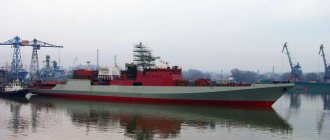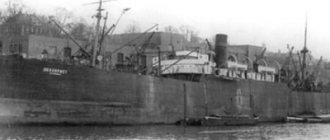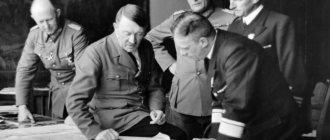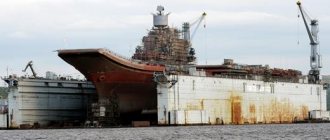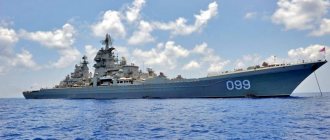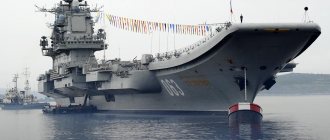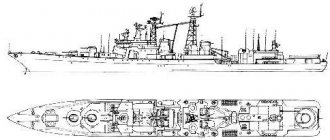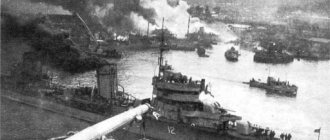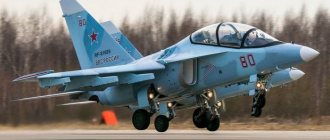Five facts from the history of the flagship of the Russian Navy, the heavy aircraft-carrying cruiser Admiral of the Fleet of the Soviet Union Kuznetsov
The heavy aircraft-carrying cruiser (TAVKR) "Admiral of the Fleet of the Soviet Union Kuznetsov", accepted by the fleet on December 25, 1990, is considered the largest ship in the Russian Navy. It is not surprising that it is he who proudly bears the title of flagship of the Russian Navy, while at the same time being the flagship of the Northern Fleet, where he serves. “Admiral Kuznetsov” is also unique in that it is the only real aircraft carrier in Russia, that is, a ship that can accommodate horizontal take-off and landing aircraft. And this is far from the only remarkable fact in its history.
Five names of one cruiser
“Admiral Kuznetsov” can perhaps be called a record holder for the number of names that this ship changed before it entered service. In the project he bore the name “Soviet Union”. It was no coincidence that the ship received such an honor: it was supposed to become the first Soviet aircraft carrier! But when on September 1, 1982, a new heavy aircraft-carrying cruiser was laid down at the Nikolaev plant, it was given the name “Riga”, since, according to tradition, Soviet aircraft-carrying ships were named after the capitals of the union republics. A little over two months later, Soviet leader Leonid Brezhnev died, and on February 22, 1983, the ship was re-laid with a new name - in honor of the deceased General Secretary. As the Leonid Brezhnev cruiser, it was launched on December 4, 1985. Two years later, in the wake of perestroika, it was renamed “Tbilisi”. And on October 4, 1990, he received his fifth and final name, which he bears to this day: “Admiral of the Fleet of the Soviet Union Kuznetsov,” in honor of the legendary Nikolai Kuznetsov, the first of the Soviet naval commanders to speak out for the construction of his own aircraft carriers.
TAKR "Kuznetsov". History of construction and service
As we said earlier, the heavy aircraft-carrying cruiser “Admiral of the Fleet of the Soviet Union Kuznetsov” (hereinafter referred to as “Kuznetsov”) turned out to be too large for one article in the series. Therefore, before taking on its description, in three separate articles we examined the history of the creation of aircraft-carrying ships of the USSR and their carrier-based aircraft - the Yak-141, MiG-29K and Su-33.
Next, we should talk about the design features and capabilities of our only ship capable of supporting flights of horizontal take-off and landing aircraft, but... Knowing what kind of controversy this could cause in the comments, the author of this article preferred to first talk about the service of the Kuznetsov TAKR, without anything its current state, nor the specifics of its combat use in Syria, will be clear.
Let us recall (briefly) the main tactical and technical characteristics of the only aircraft-carrying ship in Russia.
The standard displacement (according to various sources) is 45,900 - 46,540 tons, the total displacement is 58,500 - 59,100 tons. The “largest” displacement of the TAKR is also mentioned - 61,390 tons. The power of the machines (four-shaft boiler-turbine installation) is 200,000 hp. , speed – 29 knots. The range at a speed of 18 knots was supposed to be 8,000 miles. Autonomy for supplies, provisions and drinking water – 45 days. Armament - airplanes and helicopters (the total number can reach 50 aircraft), as well as 12 Granit anti-ship missiles, 192 Kinzhal missile defense systems, 8 Kortik air defense systems and 8 30-mm AK-630M installations, a Udav anti-torpedo defense missile system "(based on RBU). It was believed that this complex was capable of destroying a homing torpedo with a probability of 76%. Crew number (actual) up to 2,100 people. aircraft carrier personnel and 500 people. air groups.
The TAKR, at that time bearing the name “Riga”, was laid down on slipway “0” of the Nikolaev ChSZ in a solemn ceremony on September 1, 1982 at 15.00. Navy Commander-in-Chief S.G., present at the ceremony. Gorshkov personally attached a silver embedded board to the bottom section of the hull.
The start of construction was preceded by extensive preparations, including a major modernization of the slipway, as well as the installation of two 900-ton gantry cranes from KONE purchased in Finland. These huge structures (height - 110 m, portal size - 150 m) made it possible to move cargo weighing up to 1,500 tons. As a result, Nikolaev ChSZ received a slipway complex that allows the construction and launching of ships with a launching weight of up to 40,000 tons.
It is interesting that one of the advantages of the deal with the French to acquire Mistral-class helicopter carriers is the transfer by the French side of large-capacity block assembly technologies, which we allegedly did not own. In fact, the hull of the future Kuznetsov was assembled from 21 blocks 32 m long, 13 m high and width corresponding to the ship’s hull. Each of these blocks weighed up to 1,400 tons, the superstructure was the 22nd block.
Installation of the superstructure on the second ship of the series - at that time "Riga", and later - "Varyag"
The construction of the first block began somewhat later than the official laying, in December 1982, and it was installed on the slipway on February 22, 1983. It is interesting that during the construction of the ship, the computers of the designer, Nevsky PKB, were linked with the ChSZ computer center into a single electronic computing system , which significantly simplified access to the necessary documentation. New design methods significantly accelerated the progress of construction work. New ones (including electronic ones) were introduced everywhere; for example, it was possible to abandon the traditional markings on the plaza. Cable work, for the first time in the history of domestic shipbuilding, was carried out directly on the slipway.
The TAKR, renamed "Leonid Brezhnev", was launched on December 4, 1985, having a mass of 32,000 tons (of which the ship itself weighed 28,000 tons, the rest was ballast and other cargo), and mooring tests began on June 8, 1989. Of course, this year the ship was not yet ready to go to sea, but the need to gain practical experience in take-off and landing on the deck led to the fact that on October 21, the TAKR (now Tbilisi) left the factory berth for the first time and headed to Sevastopol . There, at a training ground near Cape Margopulo, the first tests took place, as well as overflights of the ship by Su-27K and MiG-29K fighters. On November 1, 1989, the first horizontal takeoff and landing aircraft in the history of the Russian Navy took place on the deck of a ship: at 13.46 V.G. Pugachev landed on the Su-27K with tail number 39. Moreover, the readiness of the ship even by the beginning of 1990 was 86%. State tests began on August 1, 1990 and were carried out very intensively - in 2 months and 4 days (the ship returned to the factory to eliminate the comments on October 4, 1990). The TAKR covered 16,200 miles, 454 aircraft and helicopter sorties were made from its deck . For the first time, night launch and landing of aircraft was tested.
The acceptance certificate was signed on December 25, 1990, and on January 20, 1991, the TAKR (now “Admiral of the Fleet of the Soviet Union Kuznetsov”) was enlisted in the Northern Fleet. 9 days later (January 29), the naval flag was raised over the ship for the first time.
It was assumed that Kuznetsov would spend 1991 in the Black Sea, it was even included in the 30th division of surface ships of the Black Sea Fleet, and then, in 1992, the TAKR would enter its first combat service in the Mediterranean Sea, after which it would go to the Northern Fleet . However, in November 1991, it became clear that the collapse of the USSR had become irreversible, and the situation became... let's say, unstable. As is known, at a certain period of time Ukraine laid claim to nothing less than the entire Black Sea Fleet of the USSR. The Commander-in-Chief of the Navy, Admiral Chernavin, decided to transfer the Kuznetsov to the north, and on December 1, 1991, the ship went to sea.
The first campaign of the TAKR passed without any special incidents, although, of course, there were some nuances. Already in the Aegean Sea, vibration of the third machine was detected; as it turned out later, a fishing net was wound around the propeller. It didn’t really “stick” and didn’t get in the way, so they walked with it to Gibraltar, and only there, during a two-day stay (associated, first of all, with receiving fuel), it was cut off by the efforts of the divers on board the ship. During this voyage, Kuznetsov first encountered the forces of the US Navy - an aircraft carrier strike group led by the aircraft carrier George Washington. The Americans immediately raised aircraft and began to fly over and photograph the newest aircraft carrier, and also tried to explore its physical fields. In response, ours transmitted the signal “I am conducting an exercise,” increased the speed to 24 knots and lifted both rescue helicopters into the air (unfortunately, there were no aircraft on board the Kuznetsov during this transition). The patrol ship Zadorny caught a sonar buoy from the water. There was nothing else worthy of mention in that campaign, and on December 21, 1991, the TAKR arrived at its destination. Here "Kuznetsov" was included in the 43rd division of missile cruisers based in the village of Vidyaevo.
In order to understand what happened next to our TAKR, it is necessary to stop and understand the situation in which our only heavy aircraft-carrying cruiser found itself.
The first is the largest and most complex ship of all built in the USSR. It implemented fundamentally new technologies necessary for basing horizontal takeoff and landing aircraft. Without a doubt, this was a huge step forward, but usually in such cases, ships with so much new technology suffer from many “childhood diseases” that need to be identified and “treated.”
Secondly, we can say that we inherited Kuznetsov from the USSR, but this cannot be said about its air group. The Su-33 is not even close to completing testing. Yes, it was developed in the USSR, but the development of such a complex object as a carrier-based combat aircraft is extremely difficult, and mass production should also have been organized.
Third is the issue of training deck pilots. Without a doubt, there were many professional pilots in the USSR, and there were those who piloted VTOL aircraft, but no one knew the specifics of takeoff from a springboard and landing with an arresting aid, except literally a few test pilots.
In other words, the state tests were passed, the acceptance certificate was signed, the flag was raised, and “Kuznetsov” itself arrived at its permanent location on December 21, 1991. But at the same time, we still did not have nearly a combat-ready aircraft-carrying cruiser with a staffed and trained air group as part of the fleet, and in order to obtain it, the Russian Federation needed to make a lot of effort. The problem was that the country was entering an era of political chaos and financial crises, notoriously known as the “wild nineties,” which, of course, did not at all contribute to the acquisition of combat capability of such a complex weapons system, which was the Kuznetsov TAKR.
Organizationally, the Kuznetsov air wing was formalized in February 1992, forming the 57th Smolensk Red Banner Mixed Naval Air Division (57th Scud), which included:
1. 279th naval fighter aviation regiment (279 kiap). It was to include two Su-33 squadrons and, probably, a squadron of Su-25UTG training aircraft;
2. 830th shipborne anti-submarine helicopter regiment (830 kplvp), equipped with Ka-27, Ka-27PS and Ka-29 helicopters.
In turn, 279 kiap were formed on the basis of two compounds. On the one hand, the 279th kiap became the heir to the 279 okshap (separate naval attack air regiment), which traces its history back to December 1, 1973, when the formation of the first regiment of carrier-based aircraft Yak-36M (Yak-38) for TAKR in the USSR began. Kyiv". This regiment was a pioneer in every respect: it was the first to master a completely new technology, such as VTOL aircraft, its pilots became the first pilots of carrier-based aircraft, they were the first to gain experience in sea and ocean campaigns... All this was on them, so who else if not them, was it possible to master the latest Su-33?
However, besides them, the 279th Kiap also included many officers from another formation, the 100th Research and Instruction Fighter Aviation Regiment (100th IIAP), with which... an interesting story turned out.
This regiment was created on December 24, 1985 (based at the Saki airfield, Crimea) precisely for the purpose of studying the capabilities of carrier-based aircraft, testing tactics for its use, as well as training carrier-based aviation pilots. That is, the regiment was staffed by top-class pilots who had to figure out what the Su-33, MiG-29K were and how all this could be most effectively used in combat - and then teach it to others. But the USSR collapsed, and the 100th IAP ended up on the territory of now sovereign Ukraine...
Surely, many readers of the Military Review website watched the film 72 Meters at one time. It contains an episode in which the crew of a Black Sea submarine must choose between the Ukrainian oath and service in sunny Crimea or the Arctic hills where the boat will go. With few exceptions, the crew chooses loyalty to duty, and to the sounds of “Farewell of the Slavic Woman” they leave the pier where the “ceremonial event” was planned.
This episode immediately became, as it is fashionable to say now, an Internet meme and, by the way, the reason why the rental of “72 Meters” in Ukraine was banned. But... this episode is completely not fictional. Many people found themselves in a similar dilemma, including, of course, the personnel of the research and instructional air regiment. So - about a hundred officers of the 100th IAP, including 16 pilots led by Lieutenant Colonel Timur Avtandilovich Apakidze (by the way, the commander of the 100th IAP), following not the letter, but the spirit of the oath they took, chose to leave hospitable Crimea, moving with families to the polar Severomorsk.
These people should be made into nails...
Timur Avtandilovich Apakidze in the cockpit of the Su-33
Without a doubt, these officers had unique, at that time, experience in operating carrier-based aircraft, without which the development of the Su-33 would have been extremely difficult. However, even with them, work on putting the Su-33 into service and preparing an air wing for Kuznetsov could not be resumed where they had been completed in Crimea. The fact is that the 3rd Directorate of the State Scientific Research Institute of the Air Force, which was involved in testing naval aviation, remained in Ukraine. As a result, all materials and documents on the stages of flight design and state tests of the Su-33, carried out in Crimea, turned out to be inaccessible - “brotherly” Ukraine categorically refused to transfer them to the Russian Federation. One of the Su-27Ks (T10K-7), which remained at the Kirovskoye airfield in Crimea, was also “sandwiched.”
But that was not all. NITKA remains in Crimea - a unique training complex for training carrier-based aviation pilots, capable of even simulating pitching when landing on the deck of an aircraft-carrying cruiser. Subsequently, it was nevertheless possible to agree with Ukraine on the operation of this complex, and, starting in July 1994, the training of Russian Navy aviation personnel resumed on it, but for two whole years after the appearance of the Kuznetsov in the north (1992-1993), it turned out to be not available to us. And later..., for example, in 1994, Ukraine allowed our pilots to fly to NITKA for a whole month. But it wasn’t just the complex, of course. During the Soviet era, a very complex infrastructure was created in Crimea for the development of carrier-based aircraft, and NITKA, in essence, was part of it. And in Severomorsk, besides military airfields, by and large, there was nothing.
In other words, after the collapse of the USSR, we lost the infrastructure for conducting research and training of deck pilots, as well as a lot of materials on previously performed tests. The country, of course, did not have the funds to restore all this to any extent. The only “training ground” on which state testing of the Su-33 could be resumed was, in fact, the TAKR itself. But even here, not everything was in order.
It is well known that a huge problem for our aircraft-carrying ships (and not only them) was the lack of equipped base sites. And, it must be said that some conclusions from the operation of TAKR previous projects in the USSR were nevertheless made. Thus, “Kuznetsov” in the village of Vidyaevo was awaiting a pontoon-spacer specially manufactured at ChSZ - a very complex engineering structure created specifically to ensure the basing of the latest aircraft carrier in northern conditions. For this purpose, special mooring devices, communications for supplying power to the ship, and even living quarters for service personnel were installed on the pontoon. But, of course, the Black Sea shipbuilders could not equip their creation with a powerful boiler room coupled with a power plant - it was assumed that the pontoon would only serve as a link between the ship and the corresponding land infrastructure. But they didn’t have time to build it, as a result of which there was absolutely not enough steam and electricity for Kuznetsov. As a result, like on other TAKRs before it, the Kuznetsov crew is forced to constantly keep one of its engine and boiler rooms in working order. Which, of course, had the most negative impact on the service life of the mechanisms.
Now it will be extremely difficult to say what was the reason for the first breakdowns of the Kuznetsov power plant - some believe that the issue is the initial “capriciousness” of the boiler-turbine installation, on the other hand, one should listen to those who claim that despite the well-known complexity operation, the fleet could well have coped with this if not for the chronic underfunding and low qualifications of conscripts, who simply did not have time to be trained to work with such mechanisms, as well as the difficulties that arose in obtaining spare parts and components for boilers. In any case, certain difficulties arose from the very first days of operation - warranty specialists worked on the ship, including due to the vibration of the third machine that captured the network in the Mediterranean Sea. During the next trip to sea, one of the ship’s main turbines broke down, which required a very thorough and expensive repair.
All of the above, without a doubt, largely predetermined the use of the Kuznetsov aircraft carrier in subsequent years. For three years, in the period 1992-1994, the ship spent 3-4 months at sea, the crew was trained, flight design and state tests of the Su-33 were carried out. It seems like lines full of banality, but what was behind it? In fact, it was necessary to revise the entire training program for deck pilots, excluding from it training at the NITKA training complex; it was necessary to somehow teach people to “transfer” from an unusual airfield directly to the deck. And this was in conditions when the equipment responsible for takeoff and landing operations on the ship was malfunctioning. As V.P. Zablotsky writes in his monograph dedicated to the Kuznetsov aircraft carrier:
“The most serious drawback was the mismatch between the light zones of the Luna-3 OSP and the Otvodok-Raskreposhechenie television surveillance and landing control system with the on-board radio equipment (Resistor K-42).”
In the spring of 1993, the first four production Su-33s arrived at the disposal of 279 kiaps, and 1994 became, in some way, a milestone for our carrier-based aviation. Firstly, state tests of the aircraft were completed, and the final chord was the successful interception of a Su-33 by a pair and the destruction of a La-17 target aircraft against the backdrop of the sea. Secondly, at the same time, the fleet received 24 Su-33s, which made it possible to staff our only carrier-based air regiment. However, the difficulties described above with training personnel led to the fact that by 1994 we only had a leadership group ready, consisting of 10 pilots who were allowed to fly from the ship and... difficulties still remained. The inability to use the NITKA simulator, for example, led to the fact that pilots were unable to practice night takeoffs and landings, although previously such flights were carried out from the TAKR in Crimea. As a result, we had to be content with flying only during the daytime and at dusk. A number of malfunctions in control systems did not allow our aviation to practice the group use of fighters and their joint actions with the anti-submarine group.
The 1994 test exercise demonstrated the potential capabilities of our carrier-based aircraft. The flights were carried out by six Su-33s, divided into three twins. The first of them were piloted by test pilots of the Sukhoi Design Bureau V.G. Pugachev and S.N. Melnikov, who were supposed to depict enemy aircraft striking a TAKR from a distance of about 800 km. The second pair of aircraft (T.A. Apakidze and V.V. Dubovoy) and the third (I.S. Kozhin and K.B. Kochkarev) were supposed to provide air defense for the formation, which included the TAKR outside the ship's air defense systems.
The most interesting thing about these exercises was that NATO aviation took an active part in them. When entering the designated patrol area, a pair of T.A. Apakidze - V.V. Dubovoy, using the on-board equipment of the Su-33, detected an unidentified target 280 km from the cruiser and were immediately reoriented to intercept it. The target turned out to be a Norwegian patrol aircraft, Orion; after its interception, the Su-33s returned to their assigned mission - the aircraft piloted by V.G. Pugachev and S.N. Melnikov, were discovered and “destroyed” by air-to-air missiles.
The same thing happened with the second pair of Su-33s, piloted by I.S. Kozhin and K.B. Kochkarev - while entering the patrol area, planes were discovered taking off from Norwegian airfields. By decision of the ship's control and guidance center, the pilots first intercepted the descendants of the ancient Vikings, and then continued to carry out the training mission, which was also completed.
Of course, if you compare the Northern Fleet carrier-based aviation test exercises that took place in 1994 with the training process of US aircraft carriers, you will immediately notice the disparity of scale - what are only six aircraft... However, you need to understand that our naval pilots took their first steps, and in the most difficult conditions. At the same time, these exercises already demonstrated the unconditional usefulness of a carrier-based air group consisting of horizontal take-off and landing aircraft - even of the most limited number.
Theoretically, large ships of the Northern Fleet had the ability to detect air targets 280 km away, but provided that the aircraft flies high enough so that the radio horizon does not interfere with its detection. And even having discovered such an aircraft, not a single ship in the fleet, including heavy nuclear-powered missile cruisers, had a weapon that could destroy it at such a range. Also noteworthy was the length of time the aircraft remained in the air. Unlike the Yak-38 “mast defense aircraft”, the newest Su-33 could be deployed for patrols in remote areas. Both pairs of Su-33s, having received one task, during its implementation were reoriented to another, unscheduled one (interception of NATO aircraft), successfully completed it, and then returned to fulfilling the original task without landings or refueling.
In the winter of 1994-995. "Kuznetsov" underwent the first more or less serious repair of the main boilers, including the replacement of pipes, but judging by subsequent events, it was not done very well - in 1995, while going to sea, the ship lost speed. The previously stated reasons - operation in the Far North, the complexity of the boiler-turbine installation, general underfunding and the ongoing collapse of the armed forces - led to the fact that the ship, which entered service in 1991, actually needed a major overhaul of the power plant already in 1995. Of course, this is an abnormal situation for a modern warship, but in the period 1991-1995. the situation in the fleet and in the country as a whole was infinitely far from the concept of “normal.” And instead of repairing the Kuznetsov aircraft carrier, it went on its first combat service in the Mediterranean Sea.
The launch took place on December 23, 1995, while the Kuznetsov became the basis of an aircraft carrier-multipurpose group (AMG), which, in addition to the TAKR, included the multipurpose nuclear submarine Volk (project 971 Shchuka-B), the destroyer Besstrashny (project 956), TFR "Ardent" (project 11352). They were provided by the tugboat SB-406 and the tanker Olekma of the Northern Fleet, traveling from AMG to the Bay of Biscay, and later by the tugboat Shakhtar and the tanker Ivan Bubnov. As far as the author understands, the Dniester tanker was constantly accompanied by the AMG.
Without a doubt, and despite the presence of the latest TAKR in the AMG, such a squadron was only a shadow of the naval power of the USSR, capable of permanently keeping dozens of warships and submarines in the Mediterranean. Alas, the times of the 5th OPEC are a thing of the past, and most likely forever. Nevertheless, our AMG was quite suitable for demonstrating a military presence, and its composition made it possible to practice the actions of the Kuznetsov carrier-based aircraft “in conditions close to combat.”
Unfortunately, by 1995, the 57th Scud was not ready for combat work at full strength. Thus, the 279th kiap received 24 Su-33s, so both of its squadrons were fully equipped with materiel, but only the first was “ready for marching and combat,” the aircraft of which could be distinguished by the image of an eagle on the keels (the vehicles of the second squadron had a head tiger in the same place). As a result, Kuznetsov went into his first combat service with an air group of 13 fighters, that is, a dozen Su-33s of the first squadron, as well as one pilot aircraft (T10K-9, which was assigned the number 109), two Su-25UTG training aircraft , as well as 11 Ka-27, Ka-27PS and Ka-29 helicopters from the 830th Cplvp. At the same time, there were 15 combat fighter pilots on board the Kuznetsov who were allowed to fly the Su-33 from the deck of the ship, not counting T.A. Apakidze (commander of the air division) and his deputy Colonel Vlasov (with them, respectively, 17), as well as 11 helicopter crews. Naturally, the ship's pilots were distinguished by the highest qualifications; suffice it to say that out of 15 fighter pilots, 14 were sniper pilots or 1st class pilots. The engineering and technical staff were able to match them - almost all of them had experience in servicing aircraft in combat service. In addition to the pilots of the 57th Scud, test pilots were also present at the TAKR, whose task was to conduct a series of tests of the Su-33 in the Mediterranean Sea.
The campaign lasted 110 days - starting on December 23, 1995, it ended on March 22, 1996. 14,000 miles were covered over the waters of two oceans and five seas, 30 flight shifts were carried out (that is, days during which aviation flights were carried out), during this time Su-33s made 400 (according to other sources - 524) sorties, helicopters - 700 (according to other sources - 996), including 250 to search and track submarines.
The first combat service of "Kuznetsov" had the following consequences. Firstly, it turned out that the ship is fully capable of fulfilling the role of a “floating airfield” for the aircraft based on it. So, for example, in the period from January 19 to January 23, 1996 (that is, not for 5 days in a row), 5 flight shifts were carried out and the Su-33 took off 67 times. It seems to be little, especially compared to the capabilities of the American Nimitz, designed to perform more than a hundred flights per day. But let us remember that the Kuznetsov air division had only 13 aircraft at its disposal, and the average number of sorties was 13.4 per day - that is, each aircraft took off once for five days in a row. In fact, during these five days, from 8 to 20 flights were carried out per day, that is, some aircraft carried out 2 flights in one day. Or, for example, the flights on January 26-27 - on the first day, the Su-33 made 21 sorties, on the second - 12 more, and it is not a fact that all 13 available aircraft took off. All this is quite comparable to the performance of American carrier-based aviation, but one must understand that no one set the task of ensuring the maximum number of sorties for the Kuznetsov air group. For the first time, a TAKR with a Su-33 on board entered combat service, and a lot had to be tested and worked out in practice - accordingly, we can say that the actual number of sorties per day per aircraft was not the maximum, but, so to speak, “ comfortable-working.”
The interaction of heterogeneous forces was worked out - surface and submarine ships with carrier-based aircraft. The TAKR air group successfully intercepted numerous reconnaissance and patrol aircraft of NATO countries, monitored the US AUG, helicopters detected and escorted foreign submarines, “working” together with the Wolf nuclear submarine. When Kuznetsov returned home, in the second half of March, he took part in large exercises of the Northern Fleet, in which, in addition to him, up to 40 warships and submarines, as well as up to 50 naval aircraft and helicopters were involved. During these exercises, the destroyer Besstrashny was deployed as a long-range radar patrol ship 200 km from the order in which the Kuznetsov aircraft carrier was following. Having received information from him, the Su-33, operating at a distance of 500 km from the TAKR, intercepted and “destructed” four Tu-22M3s, which were never able to reach the missile launch line at the TAKR returning from combat service. You also need to know about the TAKR, which was built in two echelons - the distant one was aimed at intercepting enemy aircraft, the near one - at destroying anti-ship missiles. In other words, of course, it is possible and necessary to say that the absence of long-range radar aircraft significantly reduces the capabilities of the Kuznetsov air group, but in no case should we forget that even in its existing form, Kuznetsov has significantly strengthened our fleet, providing it with capabilities that the fleet has never had before. The experience of the first combat service of the Kuznetsov indicated that the presence of a TAKR increases the combat stability of a naval formation operating in the far sea or ocean zone by 1.5-2 times.
Secondly... alas, the first combat service demonstrated the extreme weakness of the ship's power plant. At the very beginning of the voyage, when the TAKR was just leaving the Kola Bay, a seven-force storm began, during which two of the eight boilers failed, and at the time of returning to the base, only two boilers were working on the ship. Accordingly, in April 1996, the Kuznetsov was put under repair, from which it emerged only in the summer of 1998. It must be said that if not for the chronic underfunding of repair work, the ship would not have had to spend two whole years at the quay wall. And the quality of repairs was probably lame, and in addition, the “wild 90s”, underfunding and a decline in the qualifications of personnel had a strong impact. In the period 1998-1999, Kuznetsov continued to serve in the fleet, but in 1999, one boiler and one (out of four) GTZA completely failed.
Despite this, in 2000, Kuznetsov was supposed to go on second combat service, but it was canceled due to the tragic death of the Kursk submarine. As a result, instead of BS, the ship underwent a three-year average repair. Then, during 2004-2007, the ship again plunged into the everyday life of military service, while in 2004, as part of a ship group, it went to the North Atlantic, and from December 5, 2007 to February 3, 2008, it made another BS - a trip to the Mediterranean Sea. Then - 7 months of repairs on the Zvezdochka and service until May 2014, when the ship, having just returned from a trip to the shores of Syria, underwent a short three-month repair. Service again, and from January to June 15, 2016 - restoration of technical readiness before a new long-distance campaign and - participation in hostilities in Syria.
In general, we can say the following - for the period from January 29, 1991, when the naval flag first flew over the Kuznetsov, and until October 2022, when work began on the overhaul of the aircraft carrier, 26 years and 8 months passed. During this time, the ship was under repair for approximately 6 years and 5 months, that is, only 24% of the total time in the fleet. It should be borne in mind that under normal conditions and with timely funding, a two-year repair in 1996-98 and a three-year repair in the period 2001-2004 could have been carried out much faster, or a significantly larger volume could have been carried out in the same period repair work.
In other words, the deep-rooted opinion that Kuznetsov is stuck in repairs has no basis. The problem is different - a huge ship, which has been in the fleet for 27 years, has still not received a single major overhaul...
To be continued…
Assemble as from cubes
“Admiral Kuznetsov” was built according to a modified design, according to which four other cruisers had already been built by that time. Its main difference from them was the normal flight deck, which allowed the operation of conventional aircraft, and not only with vertical takeoff and landing, as on its predecessors. Because of this, the dimensions of the ship have increased significantly: the greatest width is 75 meters, length is 304.5 meters, height is 64.5 meters. To assemble such a ship, new technologies and techniques were required. And they were developed. “Admiral Kuznetsov” became the first ship in the USSR that was built from ready-made blocks weighing up to 1,700 tons each. There were 24 such blocks in total, including the “island” superstructure that was installed as a single block. The interior of the ship was built - also for the first time! – using three-dimensional design using computer technology.
Specifications
Technical characteristics of the ship
Taking into account the distinctive features from previous ships in the series, the characteristics of the aircraft-carrying cruiser Admiral Kuznetsov are considered separately. This applies to electronic equipment, dimensions, and some other aspects.
Electronic equipment and weapons
After modernization, many systems on the cruiser Admiral Kuznetsov were replaced. The Beysur complex is used for navigation. Electronic equipment includes about 60 types of various systems.
Among them are the BIUS "Lesorub", the "Mars-Passat" complex, the three-dimensional radar "Fregat-MA", the radar for low-flying targets "Podkat", the communication system "Buran-2" and the electronic warfare complex "Constellation BR". Aviation control is provided through Resistor-K42 and Lawn.
Power plant
The power plant of the cruiser is boiler-turbine, four-shaft. There are four GTZA TV-12-4 and eight KVG-4 boilers. The power of each of the four steam turbines is 50 thousand liters. With. Nine turbogenerators and six diesel generators produce 1500 kW each. Four five-blade propellers are used as propulsors.
Cruising range
The aircraft carrier cruiser Admiral Kuznetsov is capable of speeds of up to 29 knots (54 km/h). With this value, the range is 3850 miles. The ship's economical combat speed is 18 knots (33 km/h), allowing it to cover a distance of 7,680 miles. The usual economical speed is 14 knots (26 km/h), with which the ship is capable of traveling 8,417 miles. The ship's overall navigation endurance is 45 days.
Displacement
"Admiral Kuznetsov" has several displacement indicators depending on the load:
- standard - 46540 tons;
- normal - 53050 tons;
- total - 59100 tons;
- the largest - 61390 tons.
Depending on the weight, the draft of the ship also differs. Its values are 8.05, 8.97, 9.76 and 10.4 meters at standard, normal, full and maximum displacement, respectively.
Dimensions and weight
The dimensions of the aircraft carrier cruiser, according to Wikipedia, have the following technical characteristics:
- length of the vessel along the waterline is 270 m, maximum length is 306.45 m;
- width along the waterline - 33.41 m, greatest - 71.96 m;
- maximum height - 64.49 m.
When measured from the waterline, the height has different values. At the bow it is 31.42 m, at the midships and stern it is 25.7 m. The weight of the ship corresponds to its displacement.
First landing
Since the Admiral Kuznetsov was planned from the very beginning as a traditional aircraft carrier, the development of landing techniques on it began even before the ship entered service. For this purpose, near the city of Saki in Crimea, they created the Ground Test Simulator for Naval Aviation - NITKA, where future pilots of the naval wing trained. To ensure that the cruiser was ready to receive conventional aircraft, it was taken to sea for flight testing before construction was completed, on October 21, 1989. Eleven days later, on November 1, for the first time in Russian history, test pilot Viktor Pugachev (after whom one of the most difficult aerobatic maneuvers, the “Pugachev Cobra”, is named) landed a Su-27K fighter with horizontal takeoff and landing on the deck of a ship. On the same day, pilot Toktar Aubakirov took off from a ship deck for the first time in history on a MiG-29K aircraft. And on November 21, Pugachev made his first night landing on the deck of the future Admiral Kuznetsov.
To get into the navy, he added two years to himself
He was born on July 24, 1904 in the village of Medvedki, Arkhangelsk province. The peasant son Kolya Kuznetsov was left without a father at the age of 11, and his older brother, who lived in Arkhangelsk, took care of the guy. For some time, Kolya worked as a messenger in the port of Arkhangelsk, and then decided to enlist in the navy. He was only 15 then, but he credited himself with two extra years and was in the Northern Dvina military river flotilla.
Four years later, the promising young sailor was sent to study at the Frunze Naval School. Kuznetsov graduated with honors, receiving the right to independently choose his place of service. He chose the cruiser Chervona Ukraine, the first ship of its type built in the USSR, the newest in the fleet at that time.
After three years of service, he was sent to study at the Naval Academy. And again Kuznetsov turned out to be an excellent student, taking the position of senior assistant commander of the cruiser "Red Caucasus" after graduation. A year later, he returns to Chervona Ukraine, now as a commander.
Light cruiser "Chervona Ukraine", 1930s. Photo: Public Domain
The only aircraft carrier on the Black Sea
The predecessors of the Admiral Kuznetsov - the heavy aircraft-carrying cruisers of the Krechet project (or the Kiev class, as they are called in NATO by the name of the lead ship) - had quite powerful conventional weapons: anti-aircraft missile and artillery systems, torpedo tubes, depth charges and etc. The new cruiser was armed even more powerfully, giving it a dozen launchers of heavy Granit anti-ship missiles. Thus, it immediately ceased to be considered an aircraft carrier, since they are distinguished by the lack of their own offensive weapons other than aircraft. Due to this, “Admiral Kuznetsov” was and remains the only aircraft-carrying ship that is allowed to appear in the Black Sea. All other aircraft carriers are prohibited from entering there in accordance with the Montreux Convention adopted back in 1936, which also determines what types of ships can pass through the Bosporus and Dardanelles straits.
34-year-old People's Commissar
After Kuznetsov's return, he was appointed deputy commander of the Pacific Fleet, and soon took over the post of commander. In this position, he prepared sailors for a possible war with Japan and supervised the provision of support to Soviet troops in the battles near Lake Khasan.
In March 1939, Kuznetsov was already the Deputy People's Commissar of the Navy, and in April - People's Commissar. At 34 years old.
The rapid career growth of the late 1930s had its origins in what was referred to as the “Great Terror.” Nikolai Kuznetsov's two predecessors as People's Commissar were shot, and no one guaranteed that he would not suffer the same fate.
Before the war, the fleet was being built rapidly, and Kuznetsov was actively involved in this process. True, his proposals for the construction of heavy ships were not accepted. The Soviet leadership believed that they could take it in quantity, compensating for the lack of funds to create more technically complex ships.
The People's Commissar paid great attention to personnel training. Through his efforts, old educational institutions were preserved and new ones were opened. It was at his instigation that Navy Day was established. The irony of fate is that initially this holiday was celebrated annually on July 24, the birthday of People’s Commissar Kuznetsov himself.
People's Commissar of the USSR Navy Admiral Nikolai Gerasimovich Kuznetsov. 1939 Photo: RIA Novosti/Dmitry Kozlov
Battle flagship
The flagship of the Russian Navy, the TAVKR Admiral Kuznetsov, is not only the largest ship, but also one of the few with solid combat experience, and if we talk about domestic aircraft-carrying ships, then the only one. In the fall of 2016, the cruiser headed the Northern Fleet ships to the Mediterranean Sea, from where its planes began to strike militants of terrorist groups in the provinces of Idlib and Homs. According to domestic and foreign military experts, the pilots of the 279th separate naval fighter aviation regiment based on the Admiral Kuznetsov, who took part in the hostilities, gained unique combat experience that few active military pilots in the world can boast of. How successfully the cruiser's pilots coped with their combat missions is evidenced by the following fact: in 2022, the cruiser was awarded the Order of Ushakov, one of the highest naval awards.
Comrade Lepanto
Here he first showed himself to be an innovator. Kuznetsov taught the crew to be ready for combat in any weather conditions, and conducted training in shooting at maximum distances and at high ship speeds. The young commander believed that in reality, the winner is the one who first detects the enemy and can destroy him with the first shot.
The crew training system invented by Kuznetsov will subsequently be extended to the entire fleet.
In the summer of 1936 in Spain, the Republican government had a new military adviser, Nicholas Lepanto . Kuznetsov, who was responsible for preparing the operation of the Republican fleet and receiving cargo from the USSR, was hiding under this name.
For Spain he was awarded the Order of Lenin and the Order of the Red Banner.
Article on the topic
“Ice Campaign” by Alexei Shchastny. The feat and tragedy of the “red admiral”
"Reports from the fronts"
By the way, where is the famous aircraft carrier Admiral Kuznetsov located now? News reports that the ship and its crew are currently in Severomorsk, having returned from a long training cruise in the North Atlantic and Mediterranean. During its course, carrier-based aircraft and helicopters repeatedly practiced air combat and preventive target interception techniques.
This is where the aircraft carrier Admiral Kuznetsov is now. It should be taken into account that at any time it can be removed from the parking lot and once again go on a long hike.

